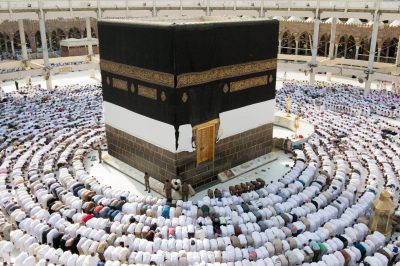The Pilgrim’s Inner Struggle
With ihram donned and internalized, a person’s shortcomings become exposed to him. All masks fall off and all deceitful convictions get destroyed.
Throughout Hajj, a person is expected to fight his behavioural inadequacies. It is a war of attrition between his newly found self and the overarching truth, on one side, and his old self (old negativities), his ego and Satan, on the other. If he wants and is ready, a pilgrim is afforded what it takes to win the war. The spoils of war are forgiveness, a new self, a new life and Paradise (Jannah).
The Prophet (peace be upon him) said that nothing but Paradise (Jannah) is the reward for an accepted Hajj.[2] Elaborating further, he said that whoever performs Hajj for Allah, and he does not have sexual relations nor commits any sin, then his previous sins will be forgiven.
In another report, the Prophet (peace be upon him) added that he who performs Hajj correctly and whose Hajj is accepted (neither approaching his wife for sexual relations nor committing any sin) will come out as sinless as a new-born child, (just delivered by his mother).[3] And obviously, for a sinless person the only reward can be Paradise.
Transformed Pilgrims
Pilgrims are the guests of their Creator. Ihram is the official uniform of the event and talbiyah the motto and, at the same time, hymn. As the munificent Host, the best thing Almighty God can offer His guests is clemency – coupled with forgiveness – and Paradise. For this reason is the life of a pilgrim after Hajj an extraordinary mood. It is about maintaining the status procured during Hajj and about remaining as pure (sinless) as possible.
Some people become paranoid. Going from one extreme to the other, certain pilgrims feel bent on repeating the occasion, and yet others – as a serious mistake and misreading, though – keep unduly postponing Hajj to their very old age, in order to live little afterwards and hence, have better chances of remaining – and dying – uncontaminated by sin.
Living through the significations of ihram is akin to declaring a “yes” to the power of the liberating spirit (soul), and a “no” to the incompetence of the impeding matter (body). As a whole, Hajj is an exploit of emancipation, and ihram is its instrument and also immediate insignia.
Having sensed the value of true freedom, a transformed pilgrim wants to cherish it forever, constantly rising through the ranks. For this reason, for example, was Makkah with its Hajj season in the late 19th and early 20th centuries a midpoint of the pan-Islamic and anticolonial sentiments. It was often recommended that it yet be turned into the seat of the caliphate institution.
Ihram: Scared & Pure
The word ihram is derived from the root “ahrama”, which means “to prohibit”. Related to the same root are the words “harrama”, “haram”, “muharram”, “hurmah” and “ihtarama”, which mean “to prohibit”, “prohibition”, “prohibited”, “sacredness” and “to honour” respectively. In passing, “hurmah” also means “wife”, in that she is deeply esteemed by her husband and is prohibited to anybody else.
Accordingly, ihram means “making one’s self sacred or prohibited (pure)”, in the worldly sense of the term, before entering the sacred and prohibited territory; that is, becoming (intending to become) a micro haram, as it were, before entering – joining – the macro haram. Defects and impurities are to be left behind as they are neither welcome, nor qualified for the unification. The situation is similar to what God said to Prophet Musa (Moses) when he arrived at the sacred valley of Tuwa to be in the private presence of God:
“Verily I am your Lord, therefore put off your shoes; surely you are in the sacred valley, Tuwa” (Ta Ha, 20:12).
Ihram, therefore, is a state of mind, of soul, and of entire being, rather than a mere act or a process. It is something to be as much done as experienced and built on. It is the foundation of Hajj in its totality.
That is why the verb “ahrama” became so comprehensive. Apart from meaning “to prohibit” it also assumed other meanings, like “to enter the state of ihram”, “to wear ihram”, “to enter the holy land”, “to enter a forbidden month”, “to seek somebody’s or something’s safety” and “to enter the (holy) state of prayer (salat)”.
With the intrinsic spiritual and human qualities of a pilgrim drawn attention to, against the backdrop of the sacredness of Makkah and its Hajj, a pilgrim’s personal sacredness becomes absolute too. He is elevated to the pedestal of inviolability firstly as human being (part of Allah’s creation) and secondly as believer (conscious servant of Allah). All of a sudden, apart from being a spectator from the fringe or the circumference, a pilgrim is being thrust into the heart of Hajj, at once as a concept and sensory experience. He becomes its object.
Prophet Muhammad & Hajj
Certainly, it was not a coincidence that the Prophet (peace be upon him) personally gave emphasis to this honourable status of believer in the framework of Hajj and its holy sites. What is more, he did it in a rather forceful fashion.
While circumambulating the holy Ka’bah, the Prophet (peace be upon him) is reported to have communicated to the Ka’bah:
“How pure you are! And how pure is your fragrance! How great you are! And how great is your sanctity! By Him in whose hands lies the soul of Muhammad, the sanctity (holiness) of a believer is greater with Allah than even your sanctity (i.e. the Ka’bah). That is (the sanctity) of his property, his blood and that we think nothing of him but good.”[4]
The Prophet (peace be upon him) also said at ‘Arafah in his historic sermon during his farewell pilgrimage:
“Verily, your blood, property and honour are sacred to one another like the sanctity of this day of yours (i.e. the day of Nahr or slaughtering of the animals of sacrifice), in this month of yours (the holy month of Dhul Hijjah) and in this city of yours (the holy city of Makkah).”[5]
Muhammad Asad & Malcolm X
In his book “The Road to Makkah” Muhammad Asad dwelled on the liberating and unifying character of Hajj. Above all, Hajj is a humanizing experience, exhibiting the intricacy of the convergence of people’s human and sacrosanct dimensions.
Muhammad Asad said, as for instance, that the sight of a desert filled with pilgrims who were resting on their way to Makkah resembled a huge army camp with innumerable tents, camels, litters, bundles, a confusion of many tongues – Arabic, Hindustani, Malay, Persian, Somali, Turkish, Pashtu, Amhara, and God knows how many more. This was a real gathering of nations; but as everyone was wearing the all-levelling ihram, the differences of origin were hardly noticeable and all the many races appeared almost like one.”[6]
Moreover, in his autobiography, Malcolm X commented that he saw “that Islam’s conversions around the world could double and triple if the colourfulness and the true spiritual-ness of the Hajj pilgrimage were properly advertised and communicated to the outside world.”
In the same vein, Malcolm X said:
“The people of all races, colours, from all over the world coming together as one: it has proved to me the power of the One God… Never have I witnessed such sincere hospitality and the overwhelming spirit of true brotherhood as is practiced by people of all colours and races here in this Ancient Holy Land, the home of Abraham, Muhammad, and all the other prophets of the Holy Scriptures.
For the past week, I have been utterly speechless and spellbound by the graciousness I see displayed all around me by people of all colours…There were tens of thousands of pilgrims, from all over the world. They were of all colours, from blue-eyed blonds to black-skinned Africans. But we were all participating in the same ritual, displaying a spirit of unity and brotherhood that my experiences in America had led me to believe never could exist between the white and the non-white.”[7]
Part 1 – The Spirituality of Hajj: An Introduction
Pages: 1 2 3


